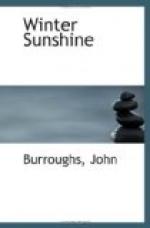A short sketch of this pilgrimage is a fair sample of these winter walks.
The delight I experienced in making this new acquisition to my geography was of itself sufficient to atone for any aches or weariness I may have felt. The mere fact that one may walk from Washington to Pumpkintown was a discovery I had been all these years in making. I had walked to Sligo, and to the Northwest Branch, and had made the Falls of the Potomac in a circuitous route of ten miles, coming suddenly upon the river in one of its wildest passes; but I little dreamed all the while that there, in a wrinkle (or shall I say furrow?) of the Maryland hills, almost visible from the outlook of the bronze squaw on the dome of the Capitol, and just around the head of Oxen Run, lay Pumpkintown.
The day was cold but the sun was bright, and the foot took hold of those hard, dry, gritty Maryland roads with the keenest relish. How the leaves of the laurel glistened! The distant oak woods suggested gray-blue smoke, while the recesses of the pines looked like the lair of Night. Beyond the District limits we struck the Marlborough pike, which, round and hard and white, held squarely to the east and was visible a mile ahead. Its friction brought up the temperature amazingly and spurred the pedestrians into their best time. As I trudged along, Thoreau’s lines came naturally to mind:—
“When the spring stirs
my blood
With the instinct of travel,
I can get enough gravel
On the old Marlborough road.”
Cold as the day was (many degrees below freezing), I heard and saw bluebirds, and as we passed along, every sheltered tangle and overgrown field or lane swarmed with snowbirds and sparrows,—the latter mainly Canada or tree sparrows, with a sprinkling of the song, and, maybe, one or two other varieties. The birds are all social and gregarious in winter, and seem drawn together by common instinct. Where you find one, you will not only find others of the same kind, but also several different kinds. The regular winter residents go in little bands, like a well-organized pioneer corps,—the jays and woodpeckers in advance, doing the heavier work; the nuthatches next, more lightly armed; and the creepers and kinglets, with their slender beaks and microscopic eyes, last of all. [Footnote: It seems to me this is a borrowed observation, but I do not know to whom to credit it.]
Now and then, among the gray and brown tints, there was a dash of scarlet,—the cardinal grosbeak, whose presence was sufficient to enliven any scene. In the leafless trees, as a ray of sunshine fell upon him, he was visible a long way off, glowing like a crimson spar,—the only bit of color in the whole landscape.




